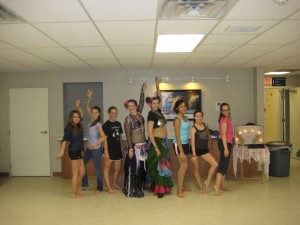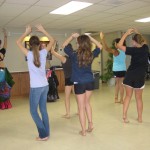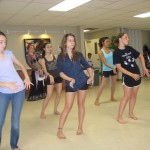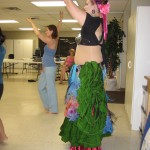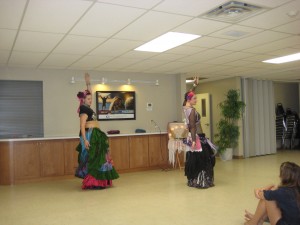The following is a handout we provide to students with guidelines on costuming for performing with the class.
For more information about our belly dance classes, please check out the class info page.
Before we begin, I should note that we use the word traditional loosely. Tribal belly dance has not been around terribly long – when we say that something is part of traditional tribal costuming, we mean that it is part of the norms established for recently invented tribal belly dance. We do not mean that it is part of any particular culture’s traditional dance costuming. That said, some items do hail originally from other cultures (and some don’t), there is much to be learned about these traditions, and it’s definitely worth doing some research.
COSTUMING GUIDELINES
Guidelines for costuming for casual performances (such as Satchels) and full performances (such as art fairs or more public performances). See the ‘Costume Pieces Definitions / Explanations’ for further information on each costuming piece and further guidelines.
SATCHELS / CASUAL PERFORMANCE GUIDELINES:
- CHOLI OR HALF TOP – Either Choli / Half top or Halter / Dance Bra (or Both) Required
- HALTER OR DANCE BRA – Either Choli / Half top or Halter / Dance Bra (or Both) Required
- BELLY COVER – Optional
- HIP SCARVES – at least one Required
- TASSEL BELT – Preferred
- OTHER HIP DECORATION – Optional
- SKIRT(S) – Either Long Full Skirt or Full Pants (or Both) Required
- PANTS – Ether Long Full Skirt or Full Pants (or Both) Required
- SHOES – Optional, but a good idea due to the location
- JEWELRY – Required
- MAKEUP – Required
- HAIR DECORATION – Required
- COVERUP – Required
FULL PERFORMANCE GUIDELINES:
- CHOLI OR HALF TOP – Required
- HALTER OR DANCE BRA – Optional unless otherwise noted
- BELLY COVER – Optional unless otherwise noted
- HIP SCARVES – at least one Required
- TASSEL BELT – Required
- OTHER HIP DECORATION – Optional
- SKIRT(S) – Required
- PANTS – Required
- SHOES – Optional
- JEWELRY – Required
- MAKEUP – Required
- HAIR DECORATION – Required
- COVERUP – Required
COSTUME PIECES DEFINITIONS/EXPLANATIONS:
CHOLI OR HALF TOP – Shirt that cuts off around the ribcage area. Cholis are the traditional top for tribal bellydance. The hard line creates emphasizes upper body isolation and movement.
HALTER OR DANCE BRA – Decorative halter or bra style top (often w/ coins, shells, mirrors, beads, etc.) specifically made for dancing. These can (depending on cut and circumstance) be worn alone or over a choli or half top, though in tribal bellydance the more traditional way to wear them is over a choli.
BELLY COVER – form fitting shirt, leotard, or body stocking worn under the choli (optional in most circumstances). MUST be form fitting to allow for visibility of undulations, etc. This can be opaque, sheer, lace, net, etc. It should coordinate with the costume and be contrasting in color with the top and bottom (or scarves) so lines are still made for visibility of isolations.
HIP SCARVE(S) – at least one scarf – fringed, beaded, coined, or otherwise – in colors that stand out from your skirt (and belly cover if worn) – these create lines that allow your hipwork to be more visible and can be tied to create more bulk at the hips which create shape and also make hipwork more visible.
TASSEL BELT – Belt or scarf with (usually yarn) tassels. Traditional tribal bellydance attire. Tassels swing, bounce, and otherwise emphasize hip movement.
OTHER HIP DECORATION – coin belts, chain belts, etc. – Add movement, sound, and adornment.
SKIRT(S) – In most cases full, long skirts – broomstick skirts, circle skirts, 10 yard skirts, 25 yard skirts can all work. 10 and 25 yard skirts are the traditional choices. Panel skirts and shorter skirts can be layered over other skirts and very full pantaloons – especially with a lot of scarves and hip adornment, but by themselves they do not create a full enough (or covered enough) look. Skirts should in most cases be worn with pants. The exceptions would be in extremely hot and/or casual performances. In these circumstances especially, the skirt should be full and long and you should still be wearing at least hotpants underneath. Skirts (worn over pants) can be tucked up in various ways to create different looks and shapes (frequently done in traditional tribal bellydance).
PANTS – Pants should with very few exceptions be VERY full. Pantaloons (full pantaloons), flare pants, and palazzo pants are the primary acceptable choices. Pantaloons are the only pants worn in traditional tribal bellydance. The only time smaller pants are acceptable is under a skirt worn down. In that case, less full pantaloons, jazz pants, etc are acceptable.
SHOES – Shoes (usually optional) should be flexible enough for your feet to move well. The soles should allow you to turn. Shoes made specifically for dance are usually the best choices: ballet shoes, jazz shoes, Hermes sandals, lyrical shoes, etc. No matter what shoes you choose – make sure that you have practiced in the shoes and are comfortable dancing in them.
JEWELRY – At least some jewelry should be worn at ALL performances. A good guideline would be at least a necklace, a bracelet on each arm, and a ring on each hand. This is a MINIMUM. The tribal look is not understated.
MAKEUP – Makeup should be worn at ALL performances. This should be performance makeup, which is much more than you would wear for a night out. A face without makeup or minimal makeup will be washed out on stage and in pictures and its facial expression will disappear. We do not require any specific makeup palate or decorations at this time. You may use decorative markings if you so choose. If you do choose to use any decorative markings, it is a good idea to research and be sure you know if they are purely decorative or if they have meaning in certain cultures and decide if you want to portray those meanings.
HAIR DECORATION – At least some hair decoration should be worn. This can be as small as a decorative hair clip and as extensive as a headdress full of flowers and hairfalls and whatever else you can imagine. Traditional tribal headdress is a turban. We have never done turbans in our tribe.
COVERUP – Outer garment worn whenever not actually on stage — should at least cover belly (even if you are wearing a belly cover with your costume). In more formal situations, the more of the costume that can be covered up, the better (at least upper and particularly decorated portions of the costume – bra should be as covered as possible if you are wearing a costume bra). Options can include scarves tied around over the shoulder (especially for more casual performances or performances in very hot weather), veils, caps, coats, caftans, etc. The coverup should be attractive and present a nice overall appearance with your costume, as this is what the public will see any time you are not on stage. The more formal the performance, the more your cover up should cover (full caftans are popular for this type of event).










